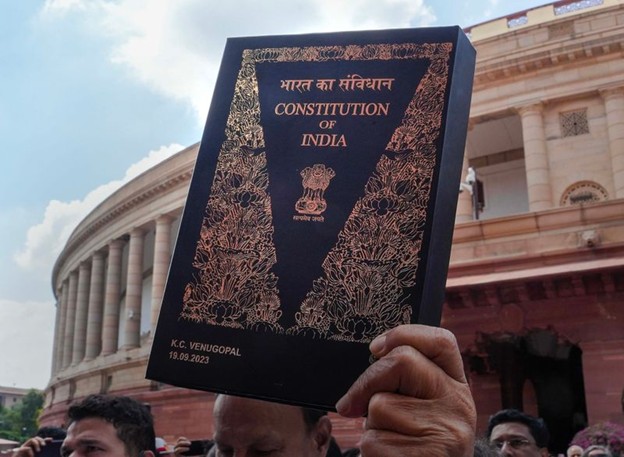As the winter sun rises over Parliament House, where the debates of 1946–49 still seem to echo, India celebrates its 76th Constitution Day. On this day in 1949, the Constituent Assembly adopted the document that gave the world its largest democracy. Today, amid fierce debates on social justice, federalism, digital rights, and institutional trust, the Constitution remains not a museum piece but a living guide. This 3,000-word feature explores its dramatic making, its visionary architects, its remarkable length, its evolving amendments, and its relevance in 2025.
The Making of the Indian Constitution: Untold Stories from the Constituent Assembly
The Constitution was not drafted in calm seclusion. Between December 9, 1946, and November 26, 1949, 299 members met for 165 days across 2,973 hours in what is now the Central Hall of Parliament. They were lawyers, poets, revolutionaries, princes, and farmers—many still reeling from Partition’s horrors.
Late-night arguments in committee rooms were as crucial as public sessions. A lesser-known member from Punjab pushed hard for land reforms that later shaped the Directive Principles. Another quietly ensured rural realities found space in a document otherwise dominated by urban elites. Drafting Committee members sifted through more than 7,000 proposed amendments, often clashing over secularism, emergency powers, and a uniform civil code.
One member famously warned during a debate on emergency provisions, “We are forging chains for our own liberty”—a prophetic remark that would haunt the nation in 1975. Another smuggled ideas from Irish and Canadian models while fiercely rejecting colonial remnants. The final product was a revolution achieved without bloodshed: colonial subjects transformed into sovereign citizens through argument, compromise, and extraordinary foresight.
Women in the Constituent Assembly: Their Role and Legacy
Only fifteen women sat in the Assembly—just five percent—yet their contributions were monumental. One became the first Health Minister and insisted on maternity relief and women’s health in the Directive Principles. A lone Muslim woman member rose to oppose separate electorates, declaring that differences must be sunk for the larger good—an argument that helped cement Article 14’s guarantee of equality.
Another fought for Hindu women’s inheritance rights, laying the groundwork for the 1956 Hindu Succession Act. One more ensured the Universal Declaration of Human Rights spoke of “all human beings” rather than “all men,” and brought the same spirit home. A future diplomat infused the debates with global perspective, while an educationist from the south built institutions that still empower women.
Their proposals for women’s reservation in legislatures were rejected at the time, yet female voter turnout has now surpassed men’s in many states. From triple talaq abolition to rising political participation, their quiet persistence continues to ripple through Indian democracy.
Dr. B.R. Ambedkar’s Vision: How Relevant Is It in Today’s India?
Dr. Bhimrao Ramji Ambedkar, Chairman of the Drafting Committee, saw political democracy as meaningless without social and economic democracy. He warned that caste hierarchy would destroy the nation unless deliberately dismantled. Articles 14–18 on equality and the abolition of untouchability remain his direct imprint.
His caution that a Constitution is only as good as the people who work it rings truer than ever when over 50,000 crimes against Dalits are recorded annually and economic inequality rivals the Gilded Age. His push for land reform, education, and inter-caste marriage as tools of emancipation still awaits full realisation. The dream of fraternity he placed at the heart of the Preamble feels especially urgent in an age of polarisation and online hate.
Yet reservations, affirmative action, and expanding educational access have lifted millions—proof that his roadmap still works when followed. In 2025, as India debates AI ethics, climate justice, and wealth redistribution, Ambedkar’s emphasis on liberty, equality, and fraternity offers the clearest moral compass available.
How India’s Constitution Became One of the Longest in the World
India’s Constitution originally contained 395 articles and eight schedules; today it exceeds 470 articles and 146,000 words—longer than the constitutions of the United States, France, and the United Kingdom combined.
The length reflects India’s complexity: a country of immense linguistic, religious, and cultural diversity emerging from colonial rule and Partition violence needed detailed safeguards. Federal relations between centre and states, lists of subjects, protections for scheduled castes and tribes, and an entire part on Directive Principles all demanded space. Emergency provisions, amendment procedures, and schedules for languages and territories added further bulk.
Critics call it verbose; defenders say its detail has allowed the nation to adapt without violent rupture for seventy-five years. Every major social challenge—land reform, reservation policy, panchayati raj—found constitutional anchoring rather than requiring revolution.
26 November: Why Constitution Day Matters More Than Ever Today
Constitution Day was officially declared in 2015, but November 26 has always been sacred: the day the Constituent Assembly adopted the document in 1949. In 2025, with democratic backsliding visible across the globe, the day carries extra weight.
From schoolchildren reading the Preamble in morning assemblies to citizens taking pledges at historic sites, the nation recommits to justice, liberty, equality, and fraternity. At a time when misinformation spreads faster than truth and institutions face unprecedented strain, remembering the Constitution is an act of renewal—an affirmation that sovereignty ultimately resides in “We, the People.”
Youth and the Constitution: Are Students Aware of Their Fundamental Rights?
India has over 600 million citizens below the age of 25, yet surveys repeatedly reveal low awareness of basic rights. Many college students can quote Bollywood dialogues but stumble over Article 21 (right to life and personal liberty) or Article 19 (freedom of speech with reasonable restrictions).
Initiatives in schools and universities are trying to change this through mock parliaments, legal literacy workshops, and street plays. The goal is simple: an aware youth is harder to exploit. In an era of online trolling, data privacy battles, and climate protests, knowing one’s rights is the first step toward responsible citizenship.
From Directive Principles to Fundamental Duties: Evaluating India’s Civic Responsibility
The Directive Principles of State Policy (Part IV) were designed as non-justiciable goals—guides for future governments rather than enforceable rights. Uniform civil code, free legal aid, village panchayats, and protection of the environment all began here. Many have since become law: the Right to Education, MGNREGA, and forest rights legislation owe their existence to these once-aspirational clauses.
In 1976, the 42nd Amendment added Fundamental Duties (Article 51A)—a reminder that rights come with responsibilities: to protect the environment, promote harmony, and strive for excellence. Critics worry duties are sometimes invoked to silence dissent, yet millions of Indians showed during the pandemic and in disaster relief that civic responsibility is alive. The challenge is to balance both halves of the equation without letting one eclipse the other.
Constitutional Amendments That Shaped Modern India
More than 106 amendments in 75 years testify to the Constitution’s flexibility. The First Amendment (1951) curbed free speech to prevent hate; the 42nd (1976) added “socialist” and “secular” to the Preamble; the 44th (1978) reversed some Emergency excesses. The 73rd and 74th Amendments (1992) brought democracy to the grassroots through panchayats and municipalities. The 86th made education a fundamental right.
Each major amendment responded to a crisis or aspiration: land reform battles, linguistic reorganisation, reservation policy, economic liberalisation. The document has grown with the nation rather than ossifying.
How the Indian Judiciary Protects the Spirit of the Constitution
The judiciary has repeatedly stepped in when other organs faltered. The 1973 Kesavananda Bharati verdict established the “basic structure” doctrine: Parliament can amend the Constitution but cannot destroy its core features—democracy, secularism, federalism, judicial review.
From striking down unconstitutional amendments during the Emergency to recognising privacy as a fundamental right in 2017 and decriminalising homosexuality in 2018, the courts have expanded the Constitution’s promise. Public Interest Litigation has turned the right to clean air, water, and education into realities for millions who never stepped inside a courtroom.
The Indian Constitution vs. Other Democracies: A Comparative Perspective
The U.S. Constitution is short, rigid, and amended only 27 times in over 230 years. Britain has no single written constitution. India chose a third path: detailed yet amendable, borrowing from everywhere yet uniquely its own.
It is more adaptable than the American model, more codified than the British, and far more socially ambitious than most. Where many new democracies collapsed, India endured because its Constitution provided both stability and space for evolution. Its reservation system, linguistic states, and independent judiciary remain models for diverse societies worldwide.
A Living Document, A Shared Responsibility
Seventy-six years after its adoption, India’s Constitution remains a work in progress—forged in diversity, tempered by crisis, expanded by judicial imagination, and renewed every time citizens choose dialogue over violence.
On this Constitution Day, the message is clear: the document belongs not to lawyers or politicians alone but to every Indian. Its preamble begins with “We, the People.” Living up to that promise—defending its values, expanding its reach, and passing it intact to the next generation—is the most patriotic act any of us can perform.

